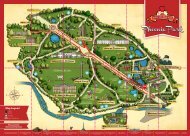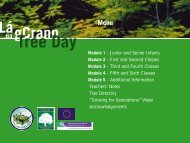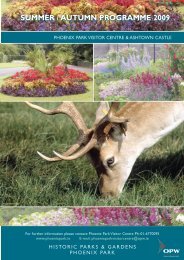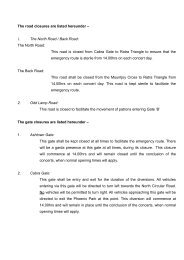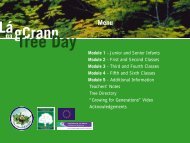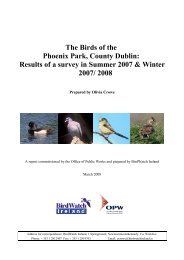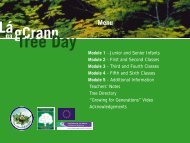Phoenix Park Conservation Management Plan
Phoenix Park Conservation Management Plan
Phoenix Park Conservation Management Plan
You also want an ePaper? Increase the reach of your titles
YUMPU automatically turns print PDFs into web optimized ePapers that Google loves.
Landscape<br />
To the north of Chesterfield Avenue, parts of the <strong>Park</strong> remain dedicated to state government functions<br />
including Áras an Uachtaráin and Ashtown Castle and Visitor Centre. The landscape tends to be smaller in<br />
scale with intimate domestic areas of parkland and gardens formed within each demesne. The more popular<br />
public facilities including Dublin Zoo and the People’s Gardens, at the eastern end of the Avenue and nearest<br />
to the city, also provide more intimate spaces to reflect their function as pleasure and recreation grounds. The<br />
southern orientation of all the prominent demesnes place the areas once occupied by military facilities and<br />
functions in the main view, perhaps with the intention of underlining the strength of 19th century government<br />
backed by military might.<br />
6.4 Views and Prospects<br />
The <strong>Phoenix</strong> <strong>Park</strong> is a designed landscape laid out on a monumental scale with wide sweeping views of the<br />
landscape and long vistas to important architectural features. Views are important in the <strong>Park</strong> landscape.<br />
They provide integrity to the layout, enhance landscape character, give a sense of space and scale and<br />
assist in creating visual interest. While the <strong>Park</strong> seems generally to be a flat plateau, the land actually falls<br />
gradually from north to south. As a consequence, the <strong>Park</strong> has a generally southerly aspect and views. The<br />
most elevated locations offer the best views across the plateau and south to the mountains. The river terraces<br />
along the southern edge, which fall steeply from the plateau to the river, offer some of the most dramatic<br />
views that in some cases include local features such as the River Liffey and the Irish National War Memorial<br />
Gardens. The <strong>Park</strong> wall and recent urban development have ensured that views to the north and west are<br />
thoroughly blocked and views eastwards are available only from a few areas close to the main gates on<br />
<strong>Park</strong>gate Street.<br />
Decimus Burton made landscape improvements to open up, frame and enhance views with new features<br />
and focal points. These are now woven into the mature fabric of the <strong>Park</strong> giving it character, interest and<br />
structure. Burton’s design assumed that the <strong>Park</strong> would be seen from the elevated height of horseback or<br />
carriage. By these means visitors would move around the <strong>Park</strong> at the moderate pace of a horse or a carriage<br />
and the landscape would be revealed as a rolling sequence of views.<br />
To facilitate enjoyment of the <strong>Park</strong>, Burton designed a network of drives that provided easy access by horse<br />
drawn vehicle. These also provided views that would sustain the interest of the viewer. The drives, which<br />
still provide the designed sequences of views, are arranged in a simple hierarchy:<br />
1. Chesterfield Avenue: the most direct east - west route, designed to demonstrate power and control and to<br />
provide impressive views of the three main demesnes and the <strong>Park</strong> landscape set against distant mountains.<br />
Along its route are the principal monuments including the <strong>Phoenix</strong> Monument midway along the avenue<br />
and an equestrian statue of Field Marshal Hugh Gough which once stood a short distance into the <strong>Park</strong> from<br />
<strong>Park</strong>gate Street and the Wellington Testimonial.<br />
2. Looped drives provide a route around the outer fringes of the <strong>Park</strong> and links to Chesterfield Avenue<br />
that pass the three demesnes, the various ornamented lodges, Dublin Zoo and several important viewpoints.<br />
Some of these routes also pass through important ‘improved’ landforms such as the Khyber Pass, Furry Glen<br />
and Oldtown Wood. These routes are laid out to provide a pleasant drive, on gentle gradients offering the<br />
most important landscape views around the <strong>Park</strong> and south to the mountains.<br />
3. Paths within areas such as Dublin Zoo and the People’s Gardens, and drives within the demesnes,<br />
generally provide inward views of features within the area concerned, but sometimes allow outward views<br />
into the <strong>Park</strong>.<br />
42<br />
THE PHOENIX PARK CONSERVATION MANAGEMENT PLAN



